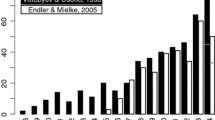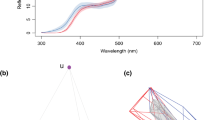Abstract
There is a growing body of data on avian eyes, including measurements of visual pigment and oil droplet spectral absorption, and of receptor densities and their distributions across the retina. These data are sufficient to predict psychophysical colour discrimination thresholds for light-adapted eyes, and hence provide a basis for relating eye design to visual needs. We examine the advantages of coloured oil droplets, UV vision and tetrachromacy for discriminating a diverse set of avian plumage spectra under natural illumination. Discriminability is enhanced both by tetrachromacy and coloured oil droplets. Oil droplets may also improve colour constancy. Comparison of the performance of a pigeon's eye, where the shortest wavelength receptor peak is at 410 nm, with that of the passerine Leiothrix, where the ultraviolet-sensitive peak is at 365 nm, generally shows a small advantage to the latter, but this advantage depends critically on the noise level in the sensitivity mechanism and on the set of spectra being viewed.
Similar content being viewed by others
Author information
Authors and Affiliations
Additional information
Accepted: 3 July 1998
Rights and permissions
About this article
Cite this article
Vorobyev, M., Osorio, D., Bennett, A. et al. Tetrachromacy, oil droplets and bird plumage colours. J Comp Physiol A 183, 621–633 (1998). https://doi.org/10.1007/s003590050286
Issue Date:
DOI: https://doi.org/10.1007/s003590050286




